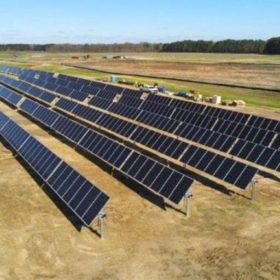The battle over approval of the Keystone XL pipeline has centered in Nebraska, through hearings and lobbying. One of the leading opposition groups, Bold Nebraska, has been deploying a “solar blockade”, by installing PV on barns and other sites along the proposed pipeline route. The grid connected installations are small, 2-3 kilowatts each, but more than symbolic, according to Bold Nebraska’s Jason Valandra. “It’s about giving power to farmers”, says Valandra, “To see the possibilities besides a pipeline getting installed”. Valandra notes Nebraska is a public power state, and Bold Nebraska is working to encourage large scale solar and wind power deployment.
The introduction of solar power as an alternative to a petroleum pipeline expands the argument into economic areas. At issue here is not just the myriad environmental impact issues of heavy fossil fuel being extracted and pumped down a continent splitting pipeline, but an economic one. But there is an alternative, such as electric vehicles and photovoltaic installations, or “EV/PV”?
The Keystone XL pipeline has two primary economic weaknesses. First is the cost of extracting and shipping the product. According to a Forbes magazine article, the betting is that if approved and operative, there will be a market for the tar sands based oil at $85 per barrel, which may be optimistic. As of August 17, NYMEX crude is $46/barrel, Brent is $50. The second is competition from electric vehicles, powered by solar, wind and other renewable sources, eliminating the need for the pipeline through demand destruction. John “Skip” Laitner, an economist in environmental and energy policy, uses the “opportunity cost” concept, and asks if there is a better way to spend the money.
“Yes, there is an opportunity cost with the XL Pipeline”, says Laitner, “Yes, it will create jobs and provide energy with its construction and operation. But, (there’s) a greater array of options, including fuel economy standards, upgrades of the nation’s homes, and moving to electric vehicles. It turns out the new fuel economy standards will save more energy than XL will deliver.”
“As suggested in the BlueGreen Alliance report…by 2030 the ~54.5 mpg will deliver about 3.2 quadrillion Btus of energy. The pipeline will deliver only 1.8 quads. Second, if we upgraded just one-fourth of our nation’s home to be 35% more energy efficient, or to use a mix of energy efficiency with PV systems, that will also more than offset the pipeline. Again, a much smaller cost with larger net benefits.”
Which goes back to a “EV/PV” alternative to Keystone. The pipeline is expected to ship a mid range of 830,000 barrels per day, or 302 million barrels annually. Out of a 42 gallon barrel (bbl), 20 bbl of gasoline could be refined, or 395,000 bbls/day, 144 million bbls/yr; the remainder is distillate, according to the U.S.Department of Energy’s Energy Information Agency. The average petroleum car goes about 10,000 miles per year, at 25 miles per gallon, or 400 gallons per year, ~10 bbls of gasoline or 22 bbls of petroleum. The pipeline would supply gasoline for about 14.4 million gasoline powered vehicles.
There are about 570,000 electric vehicles in the United States and over 2 million globally. A Union of Concerned Scientists article estimates a U.S. EV market of 3-5 million by 2025. The International Energy Agency expects a global market of over 30 million after 2020. As the Keystone XL Pipeline is designed for export, that could kill market demand as it cranked up.
What would power 14 million plus EV’s? Taking a scenario of these cars being in the United States, 10,000 miles of driving would require about 4,500 kilowatt-hours (kWh) annually. That would total to about 42 GW of installations, a little less than what the US has now.
What would be the wholesale competition of selling the energy to go 10,000 miles? At $85/bbl, selling the gasoline portion, about 20 gallons, from a refiner is about $40, or for 400 gallons for about $800 for 10,000 miles. However power contracts for solar are now as low as $0.03/kWh, or about $135 for the equivalent energy. Both are subject to markups, but you get the picture of competitiveness. And EV power could also be supplied by wind or other renewable energy sources.
PV deployment would raise land use issues, though ground mounted PV can be installed with minimal soil disturbance and feature space for agriculture, and havens for threatened wildflowers and insects. There will also be the issue of power transmission and property rights and domain. But it comes down to whether resources will be devoted to a cleaner, state-of-the-art future or the inertia of a polluted and increasingly obsolete present.
This content is protected by copyright and may not be reused. If you want to cooperate with us and would like to reuse some of our content, please contact: editors@pv-magazine.com.








By submitting this form you agree to pv magazine using your data for the purposes of publishing your comment.
Your personal data will only be disclosed or otherwise transmitted to third parties for the purposes of spam filtering or if this is necessary for technical maintenance of the website. Any other transfer to third parties will not take place unless this is justified on the basis of applicable data protection regulations or if pv magazine is legally obliged to do so.
You may revoke this consent at any time with effect for the future, in which case your personal data will be deleted immediately. Otherwise, your data will be deleted if pv magazine has processed your request or the purpose of data storage is fulfilled.
Further information on data privacy can be found in our Data Protection Policy.